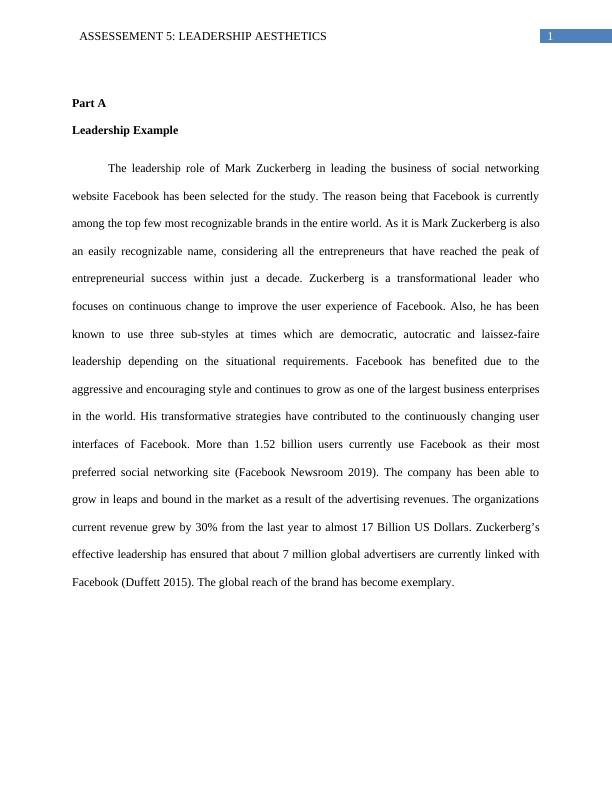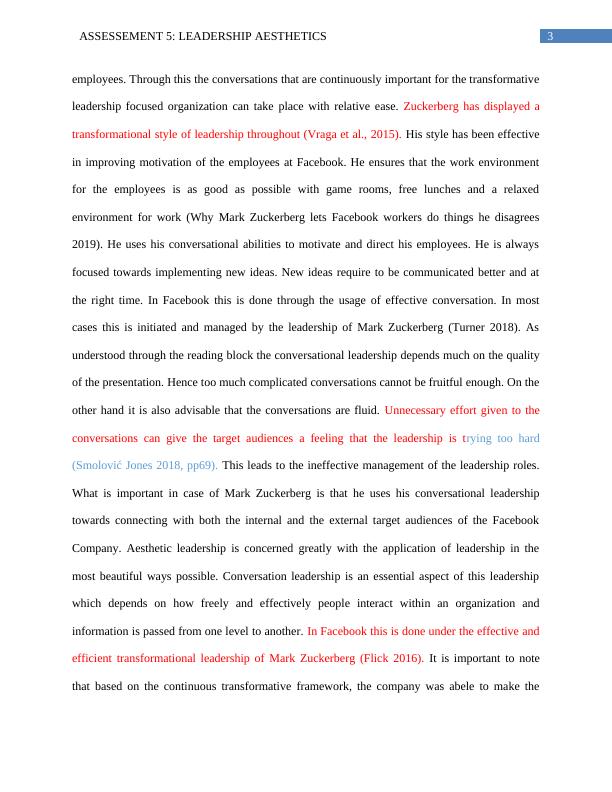Assessment 5: Leadership Aesthetics
Added on 2023-02-01
15 Pages4467 Words55 Views
Running head: ASSESSEMENT 5: LEADERSHIP AESTHETICS
ASSESSEMENT 5: LEADERSHIP AESTHETICS
Name of the Student
Name of the University
Author Note
ASSESSEMENT 5: LEADERSHIP AESTHETICS
Name of the Student
Name of the University
Author Note

1ASSESSEMENT 5: LEADERSHIP AESTHETICS
Part A
Leadership Example
The leadership role of Mark Zuckerberg in leading the business of social networking
website Facebook has been selected for the study. The reason being that Facebook is currently
among the top few most recognizable brands in the entire world. As it is Mark Zuckerberg is also
an easily recognizable name, considering all the entrepreneurs that have reached the peak of
entrepreneurial success within just a decade. Zuckerberg is a transformational leader who
focuses on continuous change to improve the user experience of Facebook. Also, he has been
known to use three sub-styles at times which are democratic, autocratic and laissez-faire
leadership depending on the situational requirements. Facebook has benefited due to the
aggressive and encouraging style and continues to grow as one of the largest business enterprises
in the world. His transformative strategies have contributed to the continuously changing user
interfaces of Facebook. More than 1.52 billion users currently use Facebook as their most
preferred social networking site (Facebook Newsroom 2019). The company has been able to
grow in leaps and bound in the market as a result of the advertising revenues. The organizations
current revenue grew by 30% from the last year to almost 17 Billion US Dollars. Zuckerberg’s
effective leadership has ensured that about 7 million global advertisers are currently linked with
Facebook (Duffett 2015). The global reach of the brand has become exemplary.
Part A
Leadership Example
The leadership role of Mark Zuckerberg in leading the business of social networking
website Facebook has been selected for the study. The reason being that Facebook is currently
among the top few most recognizable brands in the entire world. As it is Mark Zuckerberg is also
an easily recognizable name, considering all the entrepreneurs that have reached the peak of
entrepreneurial success within just a decade. Zuckerberg is a transformational leader who
focuses on continuous change to improve the user experience of Facebook. Also, he has been
known to use three sub-styles at times which are democratic, autocratic and laissez-faire
leadership depending on the situational requirements. Facebook has benefited due to the
aggressive and encouraging style and continues to grow as one of the largest business enterprises
in the world. His transformative strategies have contributed to the continuously changing user
interfaces of Facebook. More than 1.52 billion users currently use Facebook as their most
preferred social networking site (Facebook Newsroom 2019). The company has been able to
grow in leaps and bound in the market as a result of the advertising revenues. The organizations
current revenue grew by 30% from the last year to almost 17 Billion US Dollars. Zuckerberg’s
effective leadership has ensured that about 7 million global advertisers are currently linked with
Facebook (Duffett 2015). The global reach of the brand has become exemplary.

2ASSESSEMENT 5: LEADERSHIP AESTHETICS
Analysis of leadership with block concepts
There are significant leadership concepts that can be related to the leadership styles that
are displayed by Mark Zuckerberg. The growth of the social networking site has depended
essentially on continuous innovation. Some of the innovative measures that have been utilized by
the organization have also received significant criticism for jeopardizing customer data security.
Two of the block concepts that can be used for further analysis of his leadership styles are
conversational leadership and seeing leadership. This two concepts that can be understood from
the block readings, very much affect the leadership aspects and styles that are displayed by Mark
Zuckerberg.
Conversational leadership concerns how the people within an organization speak with
each other. Leadership communications should be effective and simple, they should be engaging
and participatory and they should provide a sense of where the organization is planning to do in
the future (Smolović Jones 2018, pp66). Conversational leadership is not limited to these aspects
as it also concerns how fluidly and smoothly the leadership message can be put forward to the
target audiences, whether internal or external in nature. There are also many forms of
conversational aspects of leadership. It greatly depends on the effectiveness of the conversation,
the content on the conversation, the place where the conversation is being held and the technique
in which it is put through by the leader.
Conversational leadership is a very much relatable to how Zuckerberg uses his
leadership. He is an idealist that focuses on imagining the kind of success that can be achieved in
the future with a particular innovative approach. He engages as much as possible with his
immediate subordinates and the other teams. Facebook tries to provide a homely place for their
Analysis of leadership with block concepts
There are significant leadership concepts that can be related to the leadership styles that
are displayed by Mark Zuckerberg. The growth of the social networking site has depended
essentially on continuous innovation. Some of the innovative measures that have been utilized by
the organization have also received significant criticism for jeopardizing customer data security.
Two of the block concepts that can be used for further analysis of his leadership styles are
conversational leadership and seeing leadership. This two concepts that can be understood from
the block readings, very much affect the leadership aspects and styles that are displayed by Mark
Zuckerberg.
Conversational leadership concerns how the people within an organization speak with
each other. Leadership communications should be effective and simple, they should be engaging
and participatory and they should provide a sense of where the organization is planning to do in
the future (Smolović Jones 2018, pp66). Conversational leadership is not limited to these aspects
as it also concerns how fluidly and smoothly the leadership message can be put forward to the
target audiences, whether internal or external in nature. There are also many forms of
conversational aspects of leadership. It greatly depends on the effectiveness of the conversation,
the content on the conversation, the place where the conversation is being held and the technique
in which it is put through by the leader.
Conversational leadership is a very much relatable to how Zuckerberg uses his
leadership. He is an idealist that focuses on imagining the kind of success that can be achieved in
the future with a particular innovative approach. He engages as much as possible with his
immediate subordinates and the other teams. Facebook tries to provide a homely place for their

3ASSESSEMENT 5: LEADERSHIP AESTHETICS
employees. Through this the conversations that are continuously important for the transformative
leadership focused organization can take place with relative ease. Zuckerberg has displayed a
transformational style of leadership throughout (Vraga et al., 2015). His style has been effective
in improving motivation of the employees at Facebook. He ensures that the work environment
for the employees is as good as possible with game rooms, free lunches and a relaxed
environment for work (Why Mark Zuckerberg lets Facebook workers do things he disagrees
2019). He uses his conversational abilities to motivate and direct his employees. He is always
focused towards implementing new ideas. New ideas require to be communicated better and at
the right time. In Facebook this is done through the usage of effective conversation. In most
cases this is initiated and managed by the leadership of Mark Zuckerberg (Turner 2018). As
understood through the reading block the conversational leadership depends much on the quality
of the presentation. Hence too much complicated conversations cannot be fruitful enough. On the
other hand it is also advisable that the conversations are fluid. Unnecessary effort given to the
conversations can give the target audiences a feeling that the leadership is trying too hard
(Smolović Jones 2018, pp69). This leads to the ineffective management of the leadership roles.
What is important in case of Mark Zuckerberg is that he uses his conversational leadership
towards connecting with both the internal and the external target audiences of the Facebook
Company. Aesthetic leadership is concerned greatly with the application of leadership in the
most beautiful ways possible. Conversation leadership is an essential aspect of this leadership
which depends on how freely and effectively people interact within an organization and
information is passed from one level to another. In Facebook this is done under the effective and
efficient transformational leadership of Mark Zuckerberg (Flick 2016). It is important to note
that based on the continuous transformative framework, the company was abele to make the
employees. Through this the conversations that are continuously important for the transformative
leadership focused organization can take place with relative ease. Zuckerberg has displayed a
transformational style of leadership throughout (Vraga et al., 2015). His style has been effective
in improving motivation of the employees at Facebook. He ensures that the work environment
for the employees is as good as possible with game rooms, free lunches and a relaxed
environment for work (Why Mark Zuckerberg lets Facebook workers do things he disagrees
2019). He uses his conversational abilities to motivate and direct his employees. He is always
focused towards implementing new ideas. New ideas require to be communicated better and at
the right time. In Facebook this is done through the usage of effective conversation. In most
cases this is initiated and managed by the leadership of Mark Zuckerberg (Turner 2018). As
understood through the reading block the conversational leadership depends much on the quality
of the presentation. Hence too much complicated conversations cannot be fruitful enough. On the
other hand it is also advisable that the conversations are fluid. Unnecessary effort given to the
conversations can give the target audiences a feeling that the leadership is trying too hard
(Smolović Jones 2018, pp69). This leads to the ineffective management of the leadership roles.
What is important in case of Mark Zuckerberg is that he uses his conversational leadership
towards connecting with both the internal and the external target audiences of the Facebook
Company. Aesthetic leadership is concerned greatly with the application of leadership in the
most beautiful ways possible. Conversation leadership is an essential aspect of this leadership
which depends on how freely and effectively people interact within an organization and
information is passed from one level to another. In Facebook this is done under the effective and
efficient transformational leadership of Mark Zuckerberg (Flick 2016). It is important to note
that based on the continuous transformative framework, the company was abele to make the

End of preview
Want to access all the pages? Upload your documents or become a member.
Related Documents
Management and Leadershiplg...
|8
|1686
|62
Strategic Leadership: Challenges and Agility in the Case of Mark Zuckerberg and Facebooklg...
|13
|3435
|317
Stakeholder Analysis Report: Facebooklg...
|11
|2072
|176
Facebook Strategic Managementlg...
|5
|1045
|88
Profiles of Three Successful Entrepreneurslg...
|8
|2891
|45
Strategic Management of Facebooklg...
|17
|3882
|35
